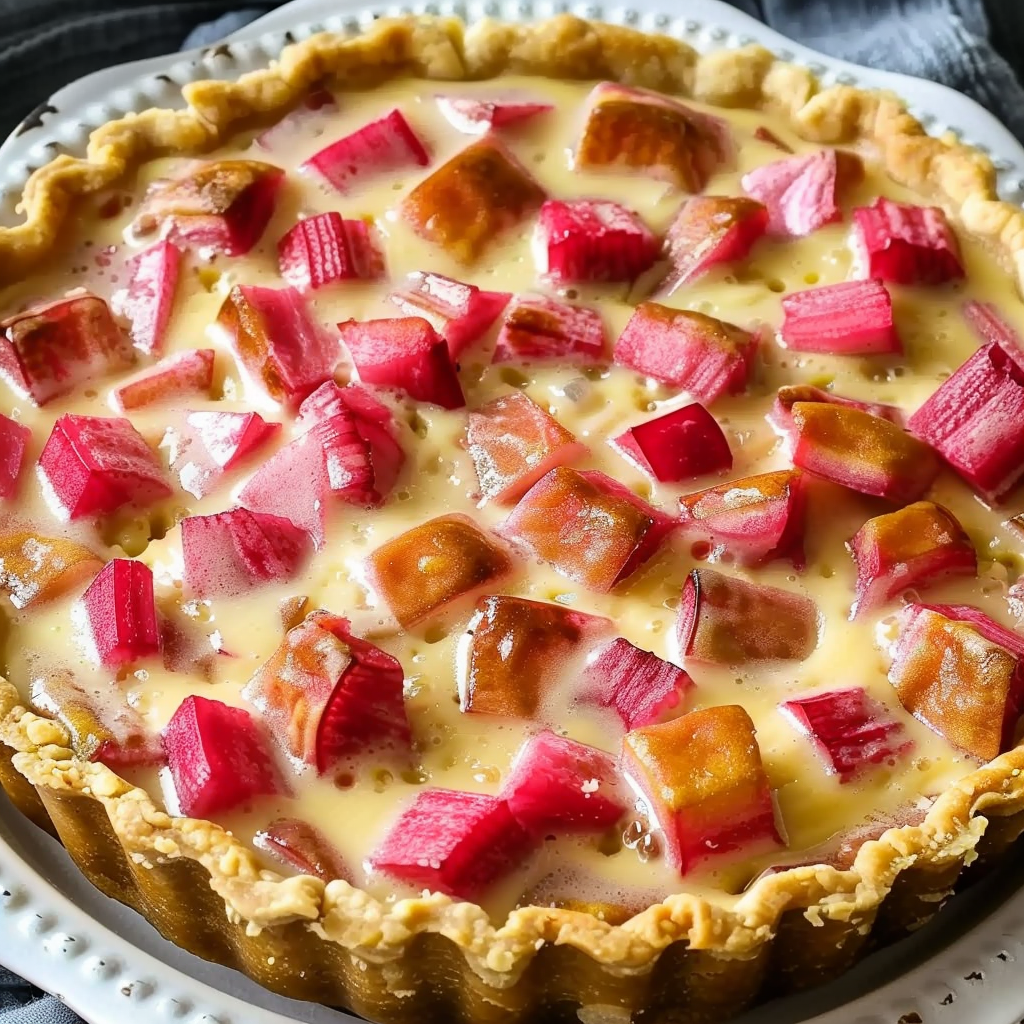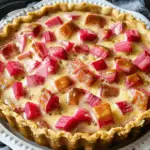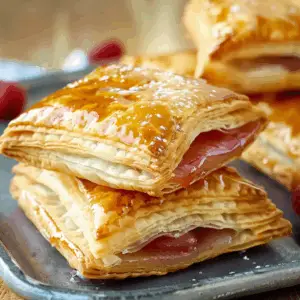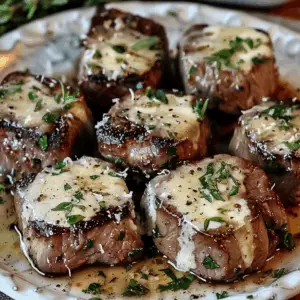Rhubarb Desserts
When it comes to old-fashioned, seasonal baking, few ingredients are as beloved—or misunderstood—as rhubarb. With its bright red stalks and bold tartness, rhubarb has long been a spring and early summer favorite in kitchens across North America and Europe. But it’s not just for traditional pies anymore. From rustic cobblers to easy crustless rhubarb pies, this versatile ingredient is making a flavorful comeback.
Whether you’re a fan of the classic rhubarb custard pie with a flaky crust or you’re drawn to the simplicity of a no-crust version, these desserts highlight the perfect balance between sweet and tart. For many home bakers, mastering a reliable rhubarb dessert means combining the sharpness of rhubarb with the creaminess of custard for that unmistakable old-fashioned flavor.
Rhubarb’s resurgence has led to a wide variety of recipe variations. Pinterest is full of rhubarb dessert ideas that go far beyond the traditional pie. From modern takes like rhubarb bars and crisps to keto-friendly options, there’s something for everyone. But for those who want dependable results and familiar comfort, the classic custard-filled rhubarb pie or the quicker crustless rhubarb custard pie are still the go-to favorites. If you’re unfamiliar with rhubarb, learn more about what rhubarb is and why it’s a popular dessert staple despite being botanically classified as a vegetable.
In this article, we’ll walk through the best rhubarb recipes, including a detailed breakdown of a crustless rhubarb custard pie and a comparison to the traditional rhubarb custard pie. You’ll also find expert baking tips, pairing suggestions, creative topping ideas, and answers to the most frequently asked questions about baking with rhubarb. Whether you’re short on time or aiming for nostalgic perfection, there’s a rhubarb recipe here that fits your kitchen.
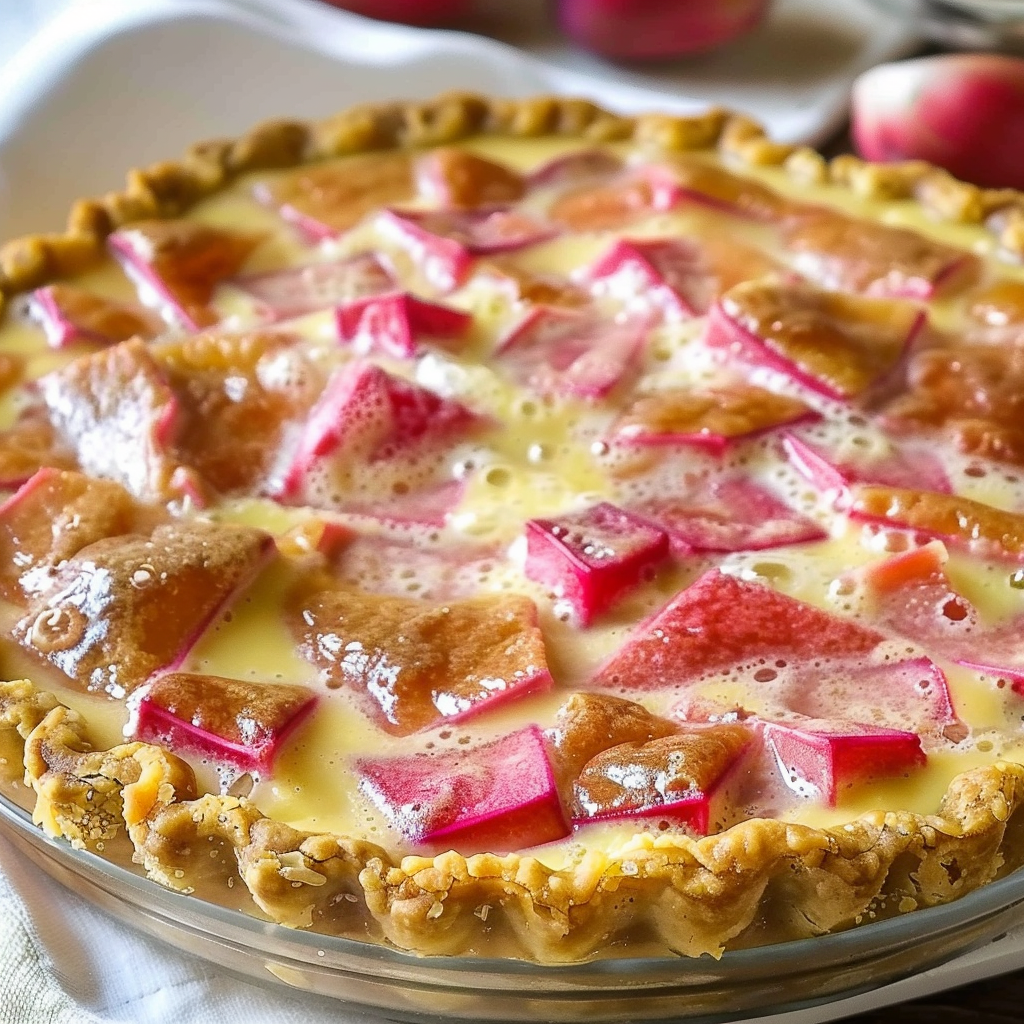
What is Rhubarb?
Rhubarb is a perennial plant known for its vividly colored stalks and uniquely tart flavor, making it a favorite in desserts like rhubarb custard pie and jams. Though often treated like a fruit in the kitchen, rhubarb is botanically classified as a vegetable. This culinary contradiction is part of what makes rhubarb so intriguing—and sometimes confusing—for home cooks.
The edible part of the rhubarb plant is the stalk; the leaves, however, contain high levels of oxalic acid and are toxic if consumed. Because of its striking red hue and sour bite, rhubarb is most often combined with sugar, custards, or other fruits to create a balanced flavor profile in desserts. Understanding the basics of what rhubarb is can help you appreciate how it complements ingredients like creamy fillings and buttery crusts.
Traditionally, rhubarb is harvested in the spring and early summer, though greenhouse varieties allow for a longer growing season. For the best flavor and texture in recipes such as crustless rhubarb pie, look for firm, crisp stalks that are brightly colored. Deep red stalks tend to be sweeter, while green stalks are usually more tart—but both work beautifully when baked into custards.
Rhubarb’s versatility extends beyond pies. It’s frequently used in chutneys, compotes, and even cocktails. For more botanical and historical context, this Wikipedia article explains rhubarb’s origins and global uses. You’ll also find inspiration by browsing Pinterest boards on rhubarb desserts, where bakers share everything from crumbles and galettes to cheesecakes.
Knowing what rhubarb is and how it behaves when cooked is key to mastering the recipes featured in this article. Whether you’re baking a classic rhubarb custard pie or experimenting with a modern crustless version, understanding the ingredient is the first step toward success.
Health Benefits of Rhubarb
While rhubarb is most commonly known for its role in sweet desserts, it also boasts several nutritional benefits that make it worth adding to your seasonal menu. Often overlooked as just a pie filling, rhubarb offers a combination of fiber, antioxidants, and essential vitamins that support overall health.
One of the primary advantages of rhubarb is its high fiber content. A serving of cooked rhubarb provides a good dose of dietary fiber, which supports digestion and promotes a healthy gut. This makes it a smart ingredient in indulgent desserts like rhubarb custard pie, especially when balanced with minimal added sugars or used in crustless recipes that reduce fat content.
According to Wikipedia’s nutrition profile on rhubarb, rhubarb also contains vitamin K, calcium, and antioxidants such as anthocyanins and polyphenols. These compounds have been linked to anti-inflammatory and heart-protective benefits. When combined with custards made from eggs and milk, as in a classic rhubarb custard pie, you’re creating a dessert that is both satisfying and nutrient-rich.
Additionally, rhubarb is low in calories and naturally fat-free. This makes it a suitable ingredient for light, seasonal dishes, especially when prepared using healthy techniques like baking without crusts or reducing added sugar. Pinterest boards full of low-calorie rhubarb dessert ideas show just how flexible this plant can be in healthier diets.
While rhubarb shouldn’t replace vegetables in your everyday meals, its nutrient content and natural tartness make it a guilt-free addition to your dessert rotation. By understanding the health benefits of rhubarb, bakers can feel better about incorporating it into both traditional pies and contemporary recipes that cater to specific health goals.
Crustless Rhubarb Custard Pie Recipe
One of the easiest and most rewarding ways to enjoy rhubarb is by baking a crustless rhubarb custard pie. This recipe simplifies the traditional custard pie by eliminating the crust, cutting down on prep time and making it ideal for beginner bakers or anyone seeking a lighter option. Despite its simplicity, this pie delivers all the rich, tangy-sweet flavor that makes rhubarb desserts so beloved.
Ingredients:
-
4 cups chopped fresh rhubarb
-
1½ cups granulated sugar
-
1 cup all-purpose flour
-
½ teaspoon salt
-
4 large eggs
-
1½ cups milk
-
1 teaspoon vanilla extract
-
¼ cup unsalted butter, melted
Instructions:
-
Preheat your oven to 350°F (175°C).
-
Grease a 9-inch pie dish and spread the chopped rhubarb evenly across the bottom.
-
In a mixing bowl, whisk together the sugar, flour, and salt.
-
Add the eggs, milk, and vanilla extract to the dry ingredients. Whisk until smooth.
-
Stir in the melted butter until the mixture is fully combined.
-
Pour the custard over the rhubarb in the pie dish.
-
Bake for 45–50 minutes, or until the custard is set and lightly golden on top.
-
Allow to cool completely before serving. This pie is excellent chilled or at room temperature.
This pie skips the crust but retains the rich, creamy filling and the sharp, bright flavor of rhubarb. It’s especially useful for those looking for gluten-free dessert options, as it can be easily adapted by substituting all-purpose flour with gluten-free flour or almond flour. For more inspiration on alternative approaches, check out crustless pie recipes on Pinterest, which offer dozens of ways to tailor this base recipe to your dietary preferences.
Compared to its classic counterpart, this crustless rhubarb custard pie also has fewer calories and a lighter texture. That makes it perfect for warmer months or when you’re looking for a dessert that feels satisfying without being too heavy. If you’re curious about other similar fillings, the Wikipedia entry on custards gives insight into how eggs and dairy work together to create that silky consistency.
Whether you’re working with fresh farmers market stalks or frozen rhubarb from your last harvest, this pie is a fast and flavorful way to showcase the best of the season.
Variations on Crustless Rhubarb Pie
Once you’ve mastered the base recipe for a crustless rhubarb custard pie, it’s easy to get creative. Small tweaks in flavor, texture, and add-ins can completely transform the dessert while still preserving its signature sweet-tart charm. Here are some popular variations that both elevate and personalize the classic version.
-
Add Strawberries: For a classic spring pairing, mix 1–2 cups of chopped strawberries with the rhubarb. This adds natural sweetness and balances the tartness. Strawberry-rhubarb combinations are especially popular in nostalgic, farmhouse-style desserts.
-
Top with Cinnamon Sugar: Sprinkle a mixture of cinnamon and sugar over the top of the custard before baking. This creates a light crust that adds both flavor and texture. A dash of nutmeg or cardamom can also introduce subtle warmth.
-
Use Alternative Flours: Try using almond flour or oat flour in place of all-purpose flour for a nuttier flavor or a gluten-free option. For more ideas, explore vegan pie crust alternatives to adapt the recipe for dairy- or gluten-sensitive diets.
-
Make It Dairy-Free: Replace the milk with unsweetened almond, oat, or coconut milk. Use a dairy-free butter substitute for the melted butter. These changes won’t dramatically alter the structure of the pie but will make it suitable for more dietary preferences.
-
Add Citrus Zest: Stir in lemon or orange zest for a fresh, citrusy note that complements rhubarb‘s tang. This simple addition brightens the flavor and pairs beautifully with the custard base.
These variations also open the door for more visual appeal. Vibrant fruit combinations or spice-dusted tops enhance presentation—perfect for brunches or family gatherings. For additional visual inspiration, Pinterest is full of rhubarb pie topping ideas that go beyond the ordinary.
Whether you’re adjusting for dietary needs or experimenting with flavor, these small changes can turn a reliable recipe into your signature dessert. With so many customization options, the crustless rhubarb pie easily becomes a year-round favorite.
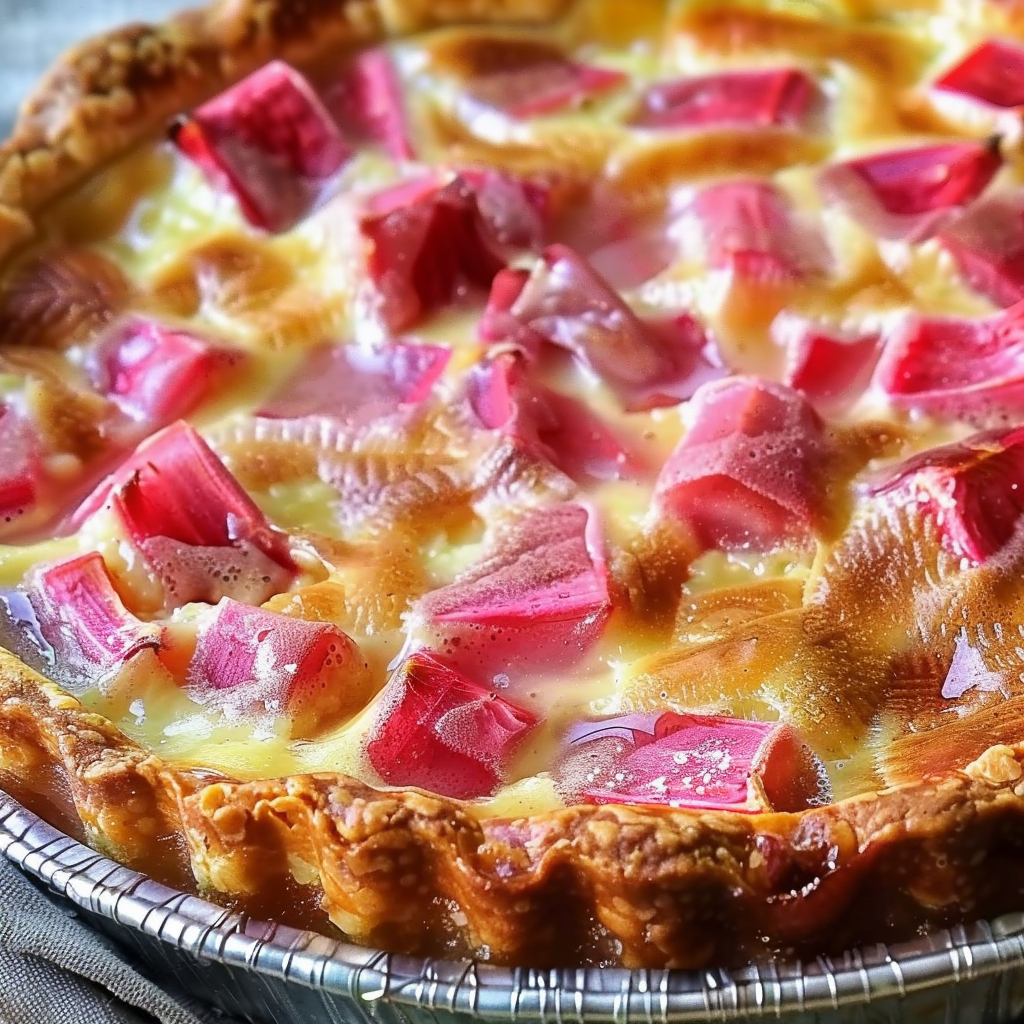
Storage and Serving Tips for Crustless Pies
After baking a crustless rhubarb custard pie, proper storage and serving can make all the difference in preserving its texture and flavor. While this dessert is easy to prepare, a few key techniques will help ensure that every slice is just as delicious as the first.
-
Cool Completely Before Serving: Allow the pie to cool fully at room temperature before slicing. This helps the custard set, resulting in cleaner, more stable slices.
-
Chill for Best Texture: While it can be served at room temperature, refrigerating the pie for at least 2–3 hours enhances the texture and flavor. The custard firms up and the tartness of the rhubarb mellows slightly, creating a balanced bite.
-
Store in the Refrigerator: Cover the pie tightly with plastic wrap or foil and refrigerate. It will keep well for up to 4 days. For best results, avoid storing it at room temperature for long periods, as the custard contains eggs and dairy.
-
Serve with Toppings: Enhance each serving with a dollop of whipped cream or a scoop of vanilla ice cream. These creamy additions complement the tartness of the rhubarb. If you’re looking for pairing ideas, tea and dessert pairings offer thoughtful inspiration—light herbal or floral teas pair especially well.
-
Avoid Freezing: Because of its custard filling, this pie doesn’t freeze well. The texture can become watery or grainy upon thawing. Instead, enjoy it fresh within a few days of baking.
For visual examples of serving styles and presentation, browsing Pinterest boards can provide ideas for garnishing, plating, and enhancing your pie’s appearance for special occasions.
With these storage and serving tips, your crustless rhubarb custard pie will maintain its creamy texture and bright flavor, making it a standout dish every time you bake it.
Classic Rhubarb Custard Pie
For those who appreciate traditional baking, the classic rhubarb custard pie delivers rich, creamy comfort wrapped in a buttery, flaky crust. This old-fashioned dessert remains a favorite across generations thanks to its perfect balance of sweet and tart flavors. The custard filling softens the rhubarb’s natural sharpness, while the crust provides structure and indulgence.
Ingredients:
-
1 unbaked 9-inch pie crust
-
3 cups chopped fresh rhubarb
-
1½ cups granulated sugar
-
¼ cup all-purpose flour
-
½ teaspoon ground nutmeg
-
¼ teaspoon salt
-
3 large eggs, beaten
-
1 cup whole milk or heavy cream
-
1 teaspoon vanilla extract
Instructions:
-
Preheat oven to 375°F (190°C).
-
Place pie crust into a 9-inch pie dish and flute the edges. Chill for 15 minutes.
-
Evenly distribute the chopped rhubarb in the crust.
-
In a bowl, mix sugar, flour, nutmeg, and salt.
-
In another bowl, whisk together eggs, milk, and vanilla. Add to the dry ingredients and stir until smooth.
-
Pour the custard mixture over the rhubarb in the pie crust.
-
Bake for 50–55 minutes, or until the center is set and the crust is golden brown. If needed, cover the edges of the crust with foil halfway through to prevent over-browning.
-
Cool completely before slicing.
Unlike the crustless version, this pie has a rich pastry base that gives each slice a hearty bite. It’s an ideal dessert for holidays and weekend baking when you have more time to prep. Understanding how the classic custard base works helps ensure the pie holds its shape and doesn’t become soggy. If you want to dive deeper into the science behind custards, explore this article on custards to see how eggs and milk create that silky texture.
Pair it with lightly whipped cream or even a berry compote to enhance the dessert without overwhelming its subtle tartness. For more presentation ideas, Pinterest’s topping guides can help you create a beautiful final dish that highlights the pie’s golden finish and pink interior.
Crustless vs. Classic Rhubarb Custard Pie: A Comparison
Both pies celebrate the unique flavor of rhubarb, but they differ in texture, preparation, and dietary compatibility. Choosing between them depends on your time, preference, and who you’re baking for.
Preparation and Time:
-
Crustless Version: Requires less prep and bakes faster. No chilling or rolling of dough needed.
-
Classic Version: Takes longer due to crust prep and sometimes blind baking. More steps, but a more traditional texture.
Flavor and Texture:
-
Crustless Pie: Softer texture throughout; custard blends directly with the rhubarb.
-
Classic Pie: Offers a contrast between creamy custard and flaky crust. More structured and sliceable.
Dietary Considerations:
-
Crustless Pie: Easily adapted for gluten-free or low-carb diets with flour substitutes.
-
Classic Pie: More indulgent, higher in calories, and less flexible for special diets.
If you’re serving a crowd or want an old-school presentation, the classic version is ideal. For weeknight baking or dietary restrictions, the crustless option is just as satisfying and far simpler. For more crustless ideas, explore crustless pie recipes on Pinterest to discover dozens of variations.
Troubleshooting Common Rhubarb Pie Issues
Even experienced bakers occasionally run into issues when working with rhubarb, especially in custard-based pies. Here’s how to avoid the most common pitfalls:
-
Custard Not Setting: Ensure the pie bakes long enough. The center should be firm, not jiggly. If underbaked, return it to the oven in 5-minute increments.
-
Watery Filling: Rhubarb naturally releases moisture. Avoid this by tossing the chopped rhubarb in a tablespoon of flour before adding it to the pie. You can also partially pre-cook it to reduce excess water.
-
Soggy Crust: Blind baking the crust for 10 minutes before filling can help prevent this. Let it cool slightly before adding the custard.
-
Burnt Edges: Cover the crust with aluminum foil halfway through baking to prevent over-browning while the filling sets.
Troubleshooting ensures the result is consistent and delicious, whether you’re baking for a party or just treating yourself.
Creative Toppings and Add-ins
Elevate your rhubarb custard pie with creative garnishes or mix-ins that add flavor, texture, or visual appeal:
-
Streusel Topping: Add a brown sugar, flour, and butter crumble before baking for a crisp finish.
-
Slivered Almonds: Sprinkle on top before baking for crunch and a hint of nuttiness.
-
Citrus Zest: Lemon or orange zest added to the custard brings a refreshing brightness.
-
Coconut Flakes: Lightly toasted coconut offers tropical flair.
-
Crushed Ginger Cookies: A unique topping that complements the tart filling with a spicy contrast.
Pinterest is a great place to discover more fruit pie topping ideas to personalize your pie and impress your guests.
Pairing Ideas: What to Serve With Rhubarb Pie
Complement your rhubarb custard pie with sides and drinks that enhance its flavor:
-
Vanilla Ice Cream: The cold creaminess balances the pie’s tartness.
-
Fresh Whipped Cream: A lighter alternative to ice cream that lets the rhubarb shine.
-
Hot Herbal Tea: Chamomile or mint teas offer delicate flavors that don’t overpower the dessert.
-
Sparkling Water with Citrus: Keeps the palate fresh between bites.
-
Berry Compote: Strawberries or raspberries add color and sweetness.
For those interested in beverage options, learn more about tea pairings with dessert to find your perfect match.
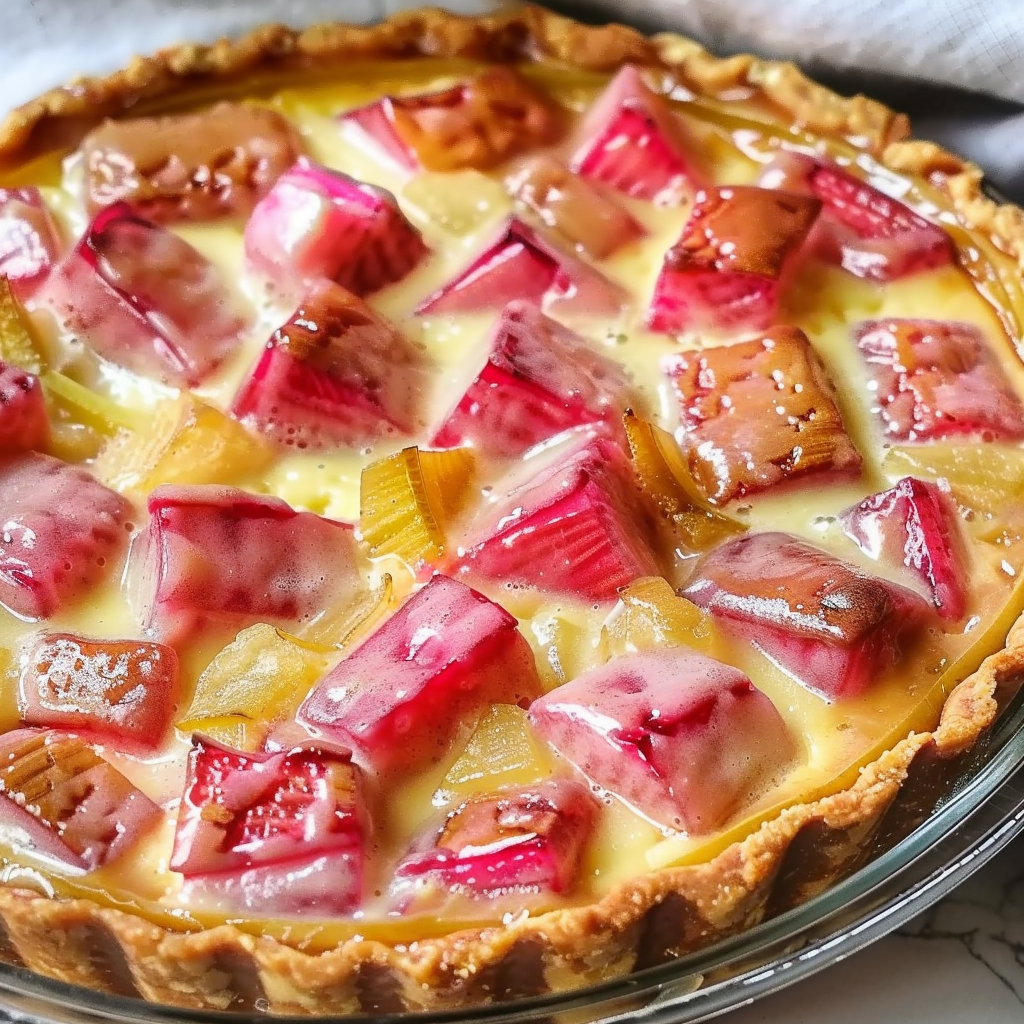
FAQs
Can I use frozen rhubarb for rhubarb custard pie?
Yes. Just thaw and drain it thoroughly before use to avoid excess moisture in your pie.
Why is my rhubarb custard pie watery?
This usually happens if the rhubarb wasn’t drained properly or if the pie was underbaked. Tossing rhubarb in a bit of flour can help.
Does rhubarb need to be cooked before baking?
No, it’s not necessary. Fresh or thawed rhubarb cooks fully during baking.
How do I make rhubarb pie less tart?
Use strawberries or add a bit more sugar to the custard. You can also use redder stalks, which are naturally sweeter.
Can you freeze rhubarb custard pie?
It’s not recommended, as custards tend to separate after freezing. Instead, try freezing chopped rhubarb alone. For tips, check out how to freeze rhubarb.
Best Rhubarb Recipes From Crustless Rhubarb Pie To Classic Custard Pie
A rich and creamy rhubarb custard pie that delivers the perfect balance of tart and sweet, this recipe can be made with or without a crust. The crustless version simplifies preparation and reduces calories without sacrificing flavor. Ideal for spring and summer, this dessert is made with fresh rhubarb, a silky egg custard, and your choice of delicious toppings. Whether served chilled or at room temperature, it’s the perfect treat for holidays, gatherings, or a weeknight indulgence.
- Author: Clara
Ingredients
- 4 cups chopped fresh rhubarb
- 1 ½ cups granulated sugar
- 1 cup all-purpose flour
- ½ teaspoon salt
- 4 large eggs
- 1 ½ cups milk
- 1 teaspoon vanilla extract
- ¼ cup unsalted butter, melted
Instructions
Preheat your oven to 350°F (175°C).
Grease a 9-inch pie dish and evenly spread the chopped rhubarb in the bottom.
In a mixing bowl, whisk together the sugar, flour, and salt.
Add the eggs, milk, and vanilla extract to the dry ingredients and whisk until smooth.
Stir in the melted butter until fully combined.
Pour the custard mixture over the rhubarb in the pie dish.
Bake in the preheated oven for about 45 to 50 minutes, or until the custard is set and the top is lightly golden.
Allow to cool before serving. Serve chilled or at room temperature.
Notes
-
Use fresh or thawed rhubarb for best results. Avoid canned varieties as they often contain added sugar or preservatives.
-
If using frozen rhubarb, be sure to drain thoroughly to avoid a soggy pie.
-
Add-ins like strawberries, almonds, or citrus zest enhance flavor and visual appeal.
-
For a gluten-free option, substitute almond or oat flour in the crustless version.
-
This pie is best served the day it’s made but keeps well in the refrigerator for up to four days.
